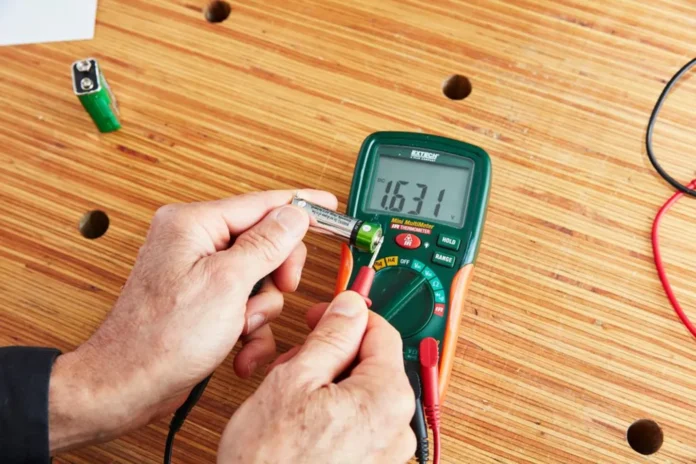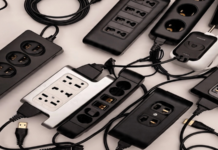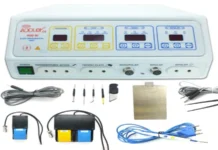In the world of electronics and electrical engineering, a digital multimeter is an indispensable tool.
Whether you are a professional technician, a DIY enthusiast, or someone who simply wants to troubleshoot electrical issues at home, understanding what a digital multimeter is and how it works is essential.
In this comprehensive guide, we will delve into the intricacies of digital multimeters, exploring their functions, components, and the various measurements they can make.
From measuring voltage and current to checking resistance and continuity, a digital multimeter is a versatile device that can assist you in a wide range of tasks.
So, if you’re ready to expand your knowledge and take your electrical troubleshooting skills to the next level, let’s dive into the world of digital multimeters together.
An Overview of A digital multimeter
A digital multimeter is a versatile and essential tool for any electrician, technician, or DIY enthusiast.
It is a handheld device that combines several measurement functions into one compact unit.
A digital multimeter, often abbreviated as DMM, is used to measure voltage, current, and resistance in electrical circuits.
It can also perform additional functions such as testing continuity, diode testing, and capacitance measurement.
Digital multimeters are equipped with a digital display that provides accurate and precise readings.
This display can show numerical values as well as graphical representations, making it easy to interpret the measurements.
The device is typically powered by batteries, allowing for portability and convenience.
One of the significant advantages of digital multimeters is their ability to measure both AC (alternating current) and DC (direct current) voltage and current.
This versatility makes them suitable for a wide range of applications, from household electrical repairs to industrial troubleshooting.
Furthermore, digital multimeters offer additional features like auto-ranging, which automatically selects the appropriate measurement range for the detected signal, eliminating the need for manual range selection.
Some models also include data logging capabilities, allowing users to save and analyze measurements later.
In conclusion, a digital multimeter is a powerful tool that simplifies electrical measurements by combining multiple functions into one device.
Its accuracy, versatility, and ease of use make it an indispensable tool for professionals and hobbyists alike.
Whether you are troubleshooting electrical issues or working on electronic projects, a digital multimeter is an essential instrument that no toolbox should be without.
Advantages And Disadvantages of A digital multimeter
In this section, we will explore the advantages and disadvantages of using a digital multimeter.
Advantages
1. Accuracy
One of the significant advantages of a digital multimeter is its high level of accuracy.
Digital displays provide precise readings, allowing for more accurate measurements compared to analog multimeters.
2. Ease To Use
Digital multimeters are user-friendly and straightforward to operate.
They often come with clear and intuitive digital displays, making it easier to interpret readings quickly.
3. Multiple Functions
A digital multimeter typically offers a wide range of functions beyond basic voltage, current, and resistance measurements.
These additional functions can include capacitance, frequency, temperature, and diode testing, among others, making it a versatile tool for various electrical tasks.
4. Auto-Ranging
Unlike analog multimeters that require manual range selection, digital multimeters often have auto-ranging capabilities.
This feature automatically adjusts the measurement range to fit the value being measured, reducing the risk of selecting an incorrect range and improving overall efficiency.
Disadvantages
1. Cost
Digital multimeters tend to be more expensive than their analog counterparts.
The advanced technology and additional features contribute to the higher price tag.
However, considering their accuracy and versatility, the investment can be well worth it for professionals and serious hobbyists.
2. Battery dependence
Digital multimeters rely on batteries for power.
If the batteries run out or are not functioning correctly, the multimeter becomes unusable until they are replaced or recharged.
This can be inconvenient, especially in urgent situations or when working in remote areas without access to power sources.
3. Fragility
Digital multimeters are generally more delicate than analog ones due to their electronic components and display screens.
They can be more susceptible to damage from drops, moisture, or extreme temperatures. Care must be taken to handle and store them safely to prevent any mishaps
How To Measure Voltage, Current, And Resistance With A Digital Multimeter
A digital multimeter is a versatile tool that every electronic enthusiast or technician should have in their toolkit.
It is used to measure various electrical quantities such as voltage, current, and resistance.
Knowing how to properly measure these parameters is crucial for diagnosing electrical problems, testing circuits, and ensuring the safety of electrical systems.
How To Measure Voltage With A Digital Multimeter
To measure voltage, you start by selecting the appropriate voltage range on the multimeter.
This is usually denoted by the letter “V” with a range of values such as 200V, 500V, or 1000V.
You then connect the probes of the multimeter to the points in the circuit where you want to measure the voltage.
The red probe is typically connected to the positive side, while the black probe is connected to the negative side.
The multimeter will display the voltage reading on its digital screen.
How To Measure Current With A Digital Multimeter
To measure current, you need to switch the multimeter to the current mode, which is usually denoted by the letter “A.”
There are two types of current measurements: DC (direct current) and AC (alternating current).
Make sure to select the appropriate mode based on the type of current you are measuring.
Next, you need to break the circuit and connect the multimeter in series with the circuit.
The red probe is connected to the positive side, and the black probe is connected to the negative side.
The multimeter will display the current reading on its screen.
How To Measure Resistance With A Digital Multimeter
Measuring resistance requires switching the multimeter to the resistance mode, usually denoted by the Greek letter “Ω” (omega).
Ensure that the circuit or component you want to measure is powered off.
Connect the probes across the component or circuit, and the multimeter will display the resistance value on its screen.
Safety Tips
Remember to always start with the highest range when measuring voltage, current, or resistance, and then switch to a lower range if necessary to get a more accurate reading.
Additionally, it is important to handle the probes carefully, ensuring good contact and avoiding any short circuits.
Factors To Consider When Choosing A Multimeter
When it comes to choosing a digital multimeter, there are several factors that you should consider to ensure you are getting the right tool for your needs.
The Measurement Capabilities Of The Multimeter
Firstly, it is important to consider the measurement capabilities of the multimeter.
Different models may have different ranges and accuracy levels for measuring voltage, current, resistance, capacitance, and other electrical parameters.
Think about the types of measurements you will be making and make sure the multimeter you choose can handle those requirements.
The Display And User Interface Of The Multimeter
Secondly, consider the display and user interface of the multimeter.
A clear, easy-to-read display is essential for quick and accurate readings.
Look for a multimeter with a backlit display that can be easily seen in different lighting conditions.
Additionally, consider the user interface – is it intuitive and user-friendly, or does it have a steep learning curve?
Safety Features
Another important factor is safety features.
Working with electricity can be dangerous, so it is essential to choose a multimeter with safety features such as overload protection, fused inputs, and CAT safety ratings.
These features will protect both you and the multimeter from potential electrical hazards.
Durability
Durability is another aspect to consider. Look for a multimeter that is well-constructed and made from high-quality materials.
It should be able to withstand the rigors of regular use and potentially survive accidental drops or impacts.
The Price And Brand Reputation
Lastly, consider the price and brand reputation.
Multimeters come in a wide range of prices, so it is important to find one that fits within your budget without compromising on quality and features.
Additionally, research the reputation of the brand and read reviews from other users to ensure you are choosing a reliable and reputable multimeter.
Note: By considering these factors, you can make an informed decision when choosing a digital multimeter that will meet your specific needs and provide accurate and reliable measurements for your electrical projects.
Tips for using a digital multimeter effectively and safely
Here are some helpful tips to ensure you get the most out of your digital multimeter:
1. Familiarize yourself with the user manual
Before using your digital multimeter, take the time to read the user manual thoroughly.
It will provide valuable information about its features, functions, and any safety precautions you need to follow.
2. Select the appropriate measurement range
Digital multimeters offer different measurement ranges for voltage, current, resistance, and other parameters.
Make sure to choose the range that matches the expected values to get accurate readings and protect the device.
3. Start with the highest range
When measuring an unknown value, it’s best to start with the highest range available on your digital multimeter and gradually decrease it until you obtain a precise measurement.
This prevents overloading the device and potential damage.
4. Use the correct probes and leads
Ensure that you are using the appropriate probes and leads for your specific measurement.
An incorrect connection can lead to inaccurate readings or even damage the multimeter.
5. Take safety precautions
Safety should always be a top priority when using a digital multimeter.
Make sure to wear protective gear like insulated gloves and goggles when working on live circuits.
Additionally, always check the condition of your multimeter’s leads, probes, and cables before using them.
6. Avoid high voltage measurements
Unless you have proper training and knowledge, it’s generally recommended to avoid measuring high-voltage circuits with a digital multimeter.
For such applications, it’s better to rely on specialized equipment and seek professional assistance.
7. Store and handle the multimeter properly
To ensure the longevity of your digital multimeter, store it in a proper case or protective pouch when not in use.
Avoid exposing it to extreme temperatures, moisture, or excessive shock.
Frequently Asked Questions Of A Digital Multimeter
A digital multimeter, often referred to as a DMM, is a versatile electronic measuring instrument used to measure various electrical quantities. It is an essential tool for professionals and hobbyists in the fields of electronics, electrical engineering, and troubleshooting.
A digital multimeter can measure several electrical parameters, including voltage, current, resistance, capacitance, frequency, and temperature. With its multiple measurement functions, it offers a wide range of applications, from checking battery voltage to diagnosing circuit problems.
A digital multimeter works by converting electrical signals into digital values for easy reading. It employs electronic circuits and probes to measure the voltage, current, or resistance of a circuit under test. The readings are then displayed on a digital screen, providing accurate and precise measurements.
Yes, digital multimeters are designed to be user-friendly and intuitive. They typically come with a dial or buttons for selecting the desired measurement function, and the readings are displayed on a clear LCD screen. However, it is important to read the user manual and follow safety precautions when using a digital multimeter, especially when dealing with high voltages.
Yes, most digital multimeters are capable of measuring both AC (alternating current) and DC (direct current) voltages and currents. This versatility allows users to work with a wide range of electrical systems and components, whether they are powered by batteries or connected to an AC power source.
Absolutely! Digital multimeters are an excellent tool for beginners, as they provide accurate measurements and are relatively easy to use. They can assist in basic electrical troubleshooting, circuit testing, and various DIY projects. However, it is crucial to familiarize yourself with the safety guidelines and basic principles of electrical measurements to ensure proper usage.
Final Thought on what is a digital multimeter
In conclusion, a digital multimeter is an essential tool for anyone who works with electronics or electrical systems.
It combines the functions of multiple measurement tools into one convenient device, allowing users to measure voltage, current, resistance, and more with ease.
Its digital display provides accurate readings and eliminates the need for manual calculations.
The versatility and accuracy of a digital multimeter make it a valuable asset for electricians, technicians, hobbyists, and even homeowners.
Whether you are troubleshooting an electrical issue, testing circuits, or simply checking battery levels, a digital multimeter is the go-to tool for accurate and reliable measurements.
Investing in a high-quality digital multimeter will not only save you time and effort but also ensure your safety by enabling you to work with confidence.
So, if you are someone who frequently deals with electrical systems or simply wants to have a handy tool for occasional use, a digital multimeter is a must-have addition to your toolkit.
Read More From Us
Electrical Switches: What You Need to Know
5 Best Hair Dryer For Fine Hair




